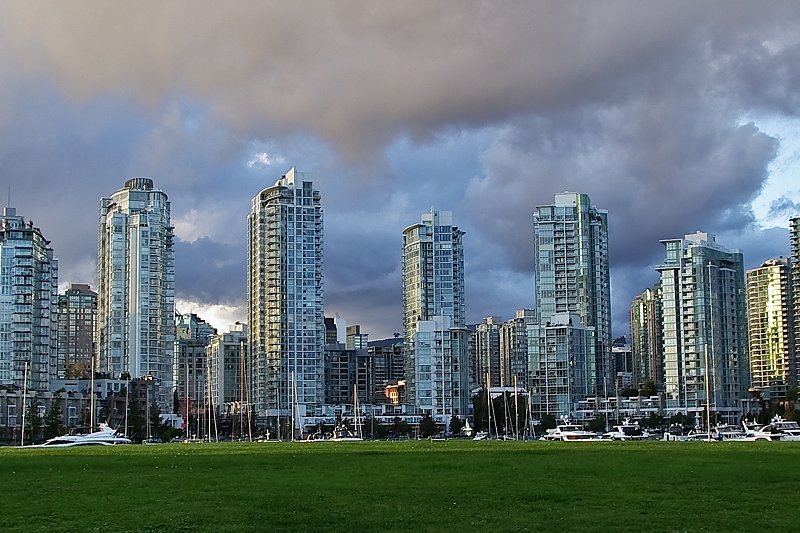 Downtown Vancouver, British Columbia
Downtown Vancouver, British ColumbiaSource: https://commons.wikimedia.org/wiki/File:False_Creek_-_3_photo_panorama.jpg
Author: David J Laporte

Cities and Major Sights in British Columbia on this website
British Columbia (BC) is the westernmost province of Canada. Along with the US states of Oregon and Washington, it is part of the Pacific Northwest. The province is bordered by Yukon in the north, Northwest Territories to the northeast, Alberta to the east, Montana to the southeast, Idaho and Washington to the south and Alaska to the northeast. British Columbia also faces the Pacific Ocean to the west. It covers 944,735 sq km (364,764 sq mi) and has a population of 4.4 million people.
The capital of British Columbia is the city of Victoria while its biggest city is Vancouver, which is also the largest city in Western Canada. Much of British Columbia experiences a cold winter temperate to subarctic climate.
Human habitation in British Columbia has been traced back at least 11,500 years. The Pacific Northwest Coast which includes British Columbia has one of the highest population density of indigenous tribes in Canada at the time of European contact. However by the late 18th century, some 30% of its natives have been brought down by introduced diseases such as small pox. Another worse epidemic, called the Great Smallpox Epidemic of 1861, killed another 50% of the indigenous people within a year.
 Peyto Lake, Banff National Park, British Columbia
Peyto Lake, Banff National Park, British ColumbiaSource: https://commons.wikimedia.org/wiki/File:Peyto_Lake-Banff_NP-Canada.jpg
Author: Tobias Alt

The first European to conduct a documented voyage of the British Columbian coast was Spanish naval officer Juan Francisco de la Bodega y Quadra, in 1775. However it was the British under James Cook in 1778 and George Vancouver in 1792-93 that established British control over the area. Apart from the explorers and surveyors, the earliest Europeans to venture inland between the Canadian Praires and the Pacific Ocean were fur trapper and traders.
By the 19th century, the North West Company and the Hudson's Bay Company were establishing a British presence in the area. Unlike in Alberta, the territory was not a concesssion to the Hudson's Bay Company, rather the company was simply granted a monopoly to trade with the natives.
In 1858, the Graser Canyon Gold Rush brought an influx of prospectors, immigrants and settlers, and this led to the establishment of the Colony of British Columbia, with its capital at New Westminster. The colony went into debt has it had to improve infrastructure to support the many communities that sprout from a series of gold rush. This in a way forced British Columbia to join the Confederation of Canada, the sixth province to do so, in 1871, on the basis of promise from the Federal Government to build a railway line connecting it with the rest of the country.
 Train crossing the North Thompson River near Kamloops, British Columbia
Train crossing the North Thompson River near Kamloops, British ColumbiaSource: https://commons.wikimedia.org/wiki/File:North_Thompson_River.jpg
Author: David Wise

Today British Columbia remains a resource-rich province. Most of its industries are resource-based. The most dominant is the forestry industry, followed by mining. it also has a motion picture industry. The volatile nature of its industries means that British Columbia is prone to dramatic economic upswings and downturns. It nonetheless has the fourth largest GDP in Canada at C$197.93 billion in 2008.
In the Canadian Parliament, British Columbia has 36 seats in the 308-seat House of Commons and 6 seats out of 105 in the Senate of Canada.
Most visitors to British Columbia come for its nature and breathtaking landscape. British Columbia has a varied mountainous terrain, pristine lakes, rivers, waterfalls and forests. Among the sport activity available here include mountaineering, fishing, kayaking, horse riding and various winter sports.
 Elfin Lakes, British Columbia
Elfin Lakes, British ColumbiaSource: https://commons.wikimedia.org/wiki/File:ElfinPano.jpg
Author: JohnHarvey

Visiting British Columbia
The Vancouver International Airport is the main gateway for visitors to British Columbia. There are also smaller airports in Victoria, Abbotsford, Cranbrook and Kelowna.Amtrak has train services connecting Seattle with Vancouver. The Canadian VIA Rail has train services that passes through Jasper National Park as it heads east.
To explore British Columbia, it may be practical to at least rent a car. Large distances is best covered by air, though this may often be quite expensive.
Towns in British Columbia
- Victoria - capital
- Vancouver - biggest city
- Abbotsford
- Burnaby
- Coquitlam
- Kamloops
- Kelowna
- Nanaimo
- Nelson
- Penticton
- Prince George
- Prince Rupert
- Surrey
- Whistler
Places of Interest in British Columbia
- Banff National Park
- Canadian Rockies
 Latest updates on Penang Travel Tips
Latest updates on Penang Travel Tips

Copyright © 2003-2025 Timothy Tye. All Rights Reserved.

 Go Back
Go Back